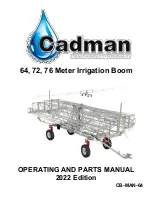
Fieldbus
Communication
•
145
ETHERNET
WAGO-I/O-SYSTEM 750
ETHERNET TCP/IP
4.1.3.4.4 DNS (Domain Name Systems)
The DNS client enables conversion of logical Internet names such as
into the appropriate decimal IP address represented with
separator stops, via a DNS server. Reverse conversion is also possible.
The addresses of the DNS server are configured via DHCP or web-based
management. Up to 2 DNS servers can be specified. The host identification
can be achieved with two functions, an internal host table is not supported.
4.1.3.4.5 SNTP-Client (Simple Network Time Protocol)
The SNTP client is used for synchronization of the time of day between a time
server (NTP and SNTP server Version 3 and 4 are supported) and the clock
module integrated in the (programmable) fieldbus coupler or controller. The
protocol is executed via a UDP port. Only unicast addressing is supported.
Configuration of the SNTP client
The configuration of the SNTP client is performed via the web-based
management system under the “Clock” link. The following parameters must
be set:
Parameter
Meaning
Address of the
Time server
The address assignment can be made either over a IP address or a host
name.
Time zone
The time zone relative to GMT (Greenwich Mean time). A range of -
12 to +12 hours is acceptable.
Update Time
The update time indicates the interval in seconds, in which the
synchronization with the time server is to take place.
Enable Time
Client
It indicates whether the SNTP Client is to be activated or deactivated.
4.1.3.4.6 FTP-Server (File Transfer Protocol)
The file transfer protocol (FTP) enables files to be exchanged between
different network stations regardless of operating system.
In the case of the ETHERNET coupler/controller, FTP is used to store and
read the HTML pages created by the user, the IEC61131 program and the
IEC61131 source code in the (programmable) fieldbus coupler or controller.
A total memory of 1.5 MB is available for the file system. The file system is
mapped to RAM disk. To permanently store the data of the RAM disk, the
information is additionally copied into the flash memory. The data is stored in
the flash after the file has been closed. Due to the storage process, access
times during write cycles are long.
















































